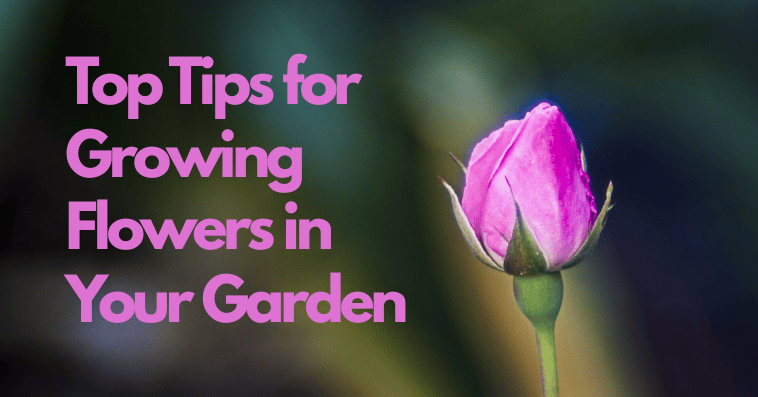If you're dreaming of a vibrant, fragrant garden full of blooming flowers, you're not alone. Whether you're a seasoned gardener or just getting started, growing flowers in your garden is one of the most rewarding hobbies. With the right tips, tools, and care, you can transform your outdoor space into a colorful paradise. In this guide, we’ll walk you through top tips for growing flowers that thrive in your garden, along with everything from soil prep to sunlight requirements.
Let’s dig in (pun intended)!
1. Choose the Right Flowering Plants for Your Region
Before you plant a single seed, it's essential to choose flowering plants that suit your local climate. Native and regional flowers are often the easiest to grow, as they are adapted to the soil, sunlight, and weather patterns of the area.
In hot climates, go for zinnias, marigolds, and portulacas.
For cooler regions, pansies, snapdragons, and tulips are ideal.
In tropical zones, hibiscus, bougainvillea, and plumeria are top picks.
Do a bit of research or ask your local nursery which flowers thrive in your area. You can also shop online at trusted nurseries like PaudheWale, where you can filter plants based on region and care requirements.
2. Understand Your Garden’s Sunlight Conditions
One of the most overlooked yet crucial aspects of flower gardening is sunlight. Different flowers have different light needs, which can make or break your blooming success.
Full sun flowers (6–8 hours of sunlight): sunflowers, lavender, roses
Partial sun flowers (3–6 hours): impatiens, begonias, fuchsias
Shade-tolerant flowers (less than 3 hours): hostas, bleeding hearts, caladiums
Observe your garden to determine where the sun hits most during the day and plan your flower beds accordingly. Matching the plant to the correct sunlight condition can dramatically increase your flowering success.
3. Prep the Soil for Maximum Bloom
Healthy flowers begin with healthy soil. Start by checking the soil pH and drainage:
Most flowers prefer slightly acidic to neutral pH (6.0 to 7.0).
The soil should be well-draining to prevent root rot.
Mix in organic compost, cocopeat, or worm castings to improve nutrient content and moisture retention. If you're starting fresh, you can order ready-to-use flower bed soil mixes from PaudheWale to save time and ensure results.
4. Watering Wisely
Overwatering is just as harmful as underwatering. Here’s how to water flowers the smart way:
Water early morning or late evening to reduce evaporation.
Use drip irrigation or a soaker hose to water directly at the roots.
Water deeply but less frequently to encourage deeper root growth.
Different flowers have different watering needs. For example, succulents like sedum need minimal water, whereas hydrangeas and petunias need consistently moist soil. Check care labels or product pages when buying flower plants online.
5. Use the Right Fertilizers
Feeding your flowers is like giving them the fuel to bloom beautifully. Use organic or balanced NPK (Nitrogen-Phosphorus-Potassium) fertilizers once every 2–4 weeks during the growing season.
Nitrogen (N) helps with leafy growth.
Phosphorus (P) boosts flowering and root development.
Potassium (K) strengthens overall plant health.
Flower-specific fertilizers are available, or you can opt for organic alternatives like bone meal, banana peels, or seaweed solution. Need help choosing? PaudheWale has a dedicated section for fertilizers for flowering plants.
6. Deadhead and Prune Regularly
Deadheading is the process of removing spent flowers. It encourages the plant to produce more blooms rather than wasting energy on seed production.
Simply pinch or snip off wilted flowers just above the first set of healthy leaves.
Regular pruning also promotes air circulation, reduces disease risk, and maintains the shape of the plant.
For plants like roses, petunias, and geraniums, consistent deadheading can dramatically improve flowering.
7. Watch Out for Pests and Diseases
A flower garden can attract unwanted visitors like aphids, mealybugs, whiteflies, and fungal infections. Here’s how to manage them:
Use neem oil sprays or organic insecticides.
Introduce beneficial insects like ladybugs.
Avoid overhead watering to reduce fungal growth.
Early detection is key. Inspect your plants every few days and act quickly if you see discolored leaves, holes, or powdery spots.
8. Mulch for Moisture and Weed Control
Adding a layer of mulch around your flowering plants offers several benefits:
Locks in moisture
Suppresses weed growth
Regulates soil temperature
Adds organic nutrients as it breaks down
Organic mulches like wood chips, coconut husk, or compost work great and are easy to source. Some flower gardeners even use colored decorative mulch to enhance visual appeal.
9. Group Flowers by Water and Light Needs
A clever trick is to group flowers based on their care requirements. This makes your job easier and your garden more organized.
For instance:
A “drought-tolerant” bed with lavender, salvia, and gazania
A “moisture-loving” bed with astilbe, calendula, and impatiens
This method also helps prevent overwatering or underwatering specific plants.
10. Start Small and Expand Gradually
If you’re new to flower gardening, don’t overwhelm yourself by planting too many varieties at once. Start with a few low-maintenance, easy-to-grow flowers like:
Marigolds
Petunias
Zinnias
Cosmos
Calendula
Once you gain confidence and understand your garden’s microclimate, you can gradually explore exotic or seasonal varieties.
Final Thoughts: Build a Blooming Garden with PaudheWale
Now that you're equipped with the top tips for growing flowers in your garden, it's time to get started! Whether you're planning a backyard flower bed or a balcony container garden, these tips will help you create a thriving, colorful oasis.
To make your gardening journey smoother, shop your flowering plants, organic fertilizers, tools, and more from PaudheWale – your one-stop online nursery for all your green needs. Their wide variety of high-quality plants and garden essentials makes it easier to get everything delivered right to your doorstep.
Let your garden bloom, beautifully and effortlessly!

